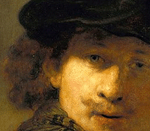
"Woe Unto You Scribes and Pharisees"
The very layout of the painting is confrontational: Jesus versus the Pharisees. Jesus (in the characteristic white that is always Christ in Tissot) stands, right hand raised, against a crowd of about nine Pharisees, all reclining in dark colors on “chair[s] of Moses.” Jesus looks them straight in the eye. Compare that to the Pharisee closest to Jesus, almost in the middle of the painting, who averts his gaze. The other two to his right do likewise: most of the rest stare back with clear hostility. The gaze of some suggests, “Not this guy again!” If there are any guilty consciences in that crowd, it doesn’t show: while averting one’s eyes might be an unconscious sign of recognizing the problem, their facial expressions largely express more obstinance than self-examination.
The confrontation occurs in the Temple, with Jesus in the open-air portico, while the Pharisees occupy their established perches. Perhaps some of those to Jesus’ right are his disciples. Past the first column on the right, we see onlookers taking in the conflict.
Born in France, James Tissot (1836−1902) enjoyed great success as a society painter in Paris and London in the 1870s and 1880s. While visiting the Church of St. Sulpice, he experienced a religious vision, after which he abandoned his former subjects and embarked on an ambitious project to illustrate the New Testament. In preparation for the work, he made expeditions to the Middle East to record the landscape, architecture, costumes, and customs of the Holy Land and its people, which he recorded in photographs, notes, and sketches. Unlike earlier artists, who had often depicted biblical figures anachronistically, Tissot painted his many figures in costumes he believed to be historically authentic, carrying out his series with considerable archaeological exactitude.